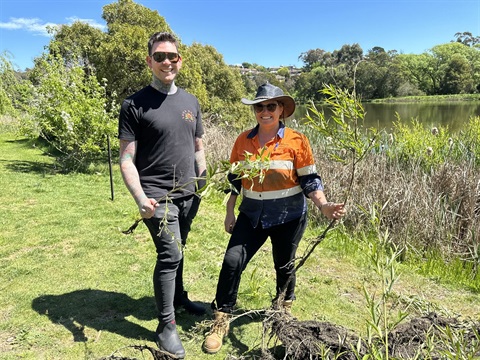Floating habitats support willow management program
Published on 18 October 2023

The City of Launceston has this week installed artificial floating bird habitats in Queechy Lake along with removing willow saplings as part of its annual willow management program.
Launceston Mayor Matthew Garwood said the Council invested significant funds into environmental management programs each year — including the willow management program.
The program seeks to reduce the environmental impacts of Salix fragilis, commonly known as Crack Willow.
"Many people don't realise the significant impact willows can have on water quality and river ecology," Mayor Garwood said.
"We know that initially willows were put into waterways because early European arrivals believed they would stabilise riverbanks.
"And that is true to an extent, but unfortunately there were some long-term unintended consequences, which we're still grappling with today.
"Many private landowners have willow removal programs, and the work the City of Launceston does through this program allows our Council to play its part as well when it comes to Council-managed land."
City of Launceston Environmental Scientist Caroline Elsner said willows were a declared weed in Tasmania under the Tasmanian Weed Management Act 1999 and that most willow species were considered Weeds of National Significance.
"Willows are able to spread by seed, but also just by small fragments of twigs being swept downstream which are then able to grow new roots and outcompete other species," Ms Elsner said.
"What you quickly end up with is only willows along your riverbank, with no understorey species.
"Willows lose their leaves at the same time, which then clogs the waterways, stops sunshine penetrating the water and impacts on the biodiversity of the waterway.
"It has impacts for birdlife, insects, fish, frogs and a whole range of species that rely on rivers as part of their lifecycles."
However, the removal of willow saplings in Queechy Lake could have unintended consequences for native waterbirds.
"Queechy Lake is more important for bird life than many people realise," Ms Elsner said.
"Some of the species of birds we find there are only found in a handful of other places in the region, including the Tamar Island wetlands.
"Queechy Lake is host to species like Royal spoonbills, different types of cormorants, and the pink-eared duck.
"A lot of the bird species you find there are not only visiting, they are making their nests and raising their young there, so it's important they have habitat.
"What we are trying to do is remove the willows but also retain good habitat for the birds, especially for the vulnerable chicks during the summer breeding season.
"The floating artificial habitats we've created are a simple design using PVC tubing, netting and native plants and habitats like this have been used in other parts of Australia to provide safe areas for waterbirds."